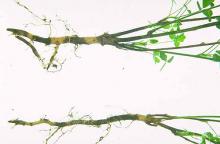Cause Phytophthora megasperma f. sp. medicaginis (= P. medicaginis), a soilborne fungus-like microorganism favored by excessive soil moisture. The microorganism survives as hardy spores in soil or infected plant debris. Irrigation water can transport the microorganism.
Symptoms Infected plants wilt in high temperatures. Foliage becomes yellow to reddish brown. The root system shows numerous dark lesions on fine roots. Tan or brownish lesions are on the taproot where lateral roots emerge; later, the taproot usually rots off within a foot of the soil surface. There is a yellowish discoloration of the root cortex. Stand thinning is noticeable in wetter locations of a field.
Cultural control
- Plant alfalfa on well-drained soils.
- Adjust irrigation practices so there is as little standing water as possible and so soils do not remain saturated long.
- Plant resistant varieties such as Agate, Apollo, and other resistant proprietary varieties.
- Break up compacted soil layers and hardpans with deep tillage to reduce wet soil pockets.
Chemical control Fungicides may effectively reduce disease severity and may be considered for alfalfa seed crops.
- Ridomil Gold SL (Group 4) at 0.25 pint/A applied as a broadcast soil surface spray at planting. Preharvest interval is 60 days for green forage and hay. 48-hr reentry.
- Warhammer (chitosan) at 4 to 12 fl oz/A on 7- to 14-day intervals. Studies at the University of Florida showed a reduction in disease severity for Phytophthora blight in squash when chitosan was applied as a 1% soil drench. No preharvest interval or reentry interval requirement.
Biological control
- Bexfond at 7 to 14 fl oz/A. 4-hr reentry. O
Reference Mo, X., and Zhang, S. 2013. Effect of chitosan, Heads Up and TiO2 on Phytophthora blight in squash, 2012. Plant Disease Management Reports 7:V081.


